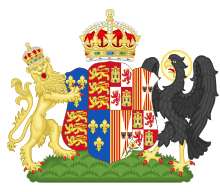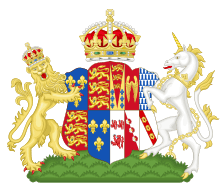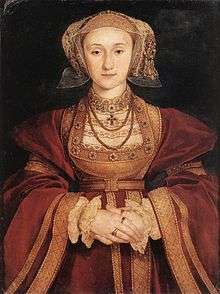List of wives of Henry VIII
.jpg)
Considered most properly Henry VIII of England only had three wives, because three of his 'marriages' were annulled. Unlike a divorce, where a married couple chooses to end their union, annulments essentially declare that a true marriage never took place[1]. However, in common parlance, the so-called wives of Henry VIII were the six queens consort wedded to Henry between 1509 and 1547.
The six women who were married to Henry VIII were, in chronological order:
- Catherine of Aragon (marriage annulled, died while detained under guard at Kimbolton Castle, mother of Mary I)
- Anne Boleyn (marriage annulled, then beheaded, mother of Elizabeth I)
- Jane Seymour (died twelve days after giving birth to Edward VI, believed to be caused by birth complications)
- Anne of Cleves (marriage annulled, outlived the rest of the wives)
- Catherine Howard (beheaded)
- Catherine Parr (widowed at death of Henry VIII, remarried to Thomas Seymour)
Henry's first marriage lasted nearly 24 years, while the remaining five totaled less than 10 years combined.
A common mnemonic device to remember the fates of Henry's consorts is "Divorced, beheaded, died, divorced, beheaded, survived". There is also a rhyme:
King Henry VIII,
To six wives he was wedded.
One died, one survived,
Two divorced, two beheaded.
It is often noted that Catherine Parr "survived him." In fact, Anne of Cleves also survived the king, and was the last of his queens to die. Of the six queens, Catherine of Aragon, Anne Boleyn, and Jane Seymour each gave Henry one child who survived infancy: two daughters and one son. All three of these children would eventually ascend to the throne: King Edward VI, Queen Mary I, and Queen Elizabeth I.
Catherine Howard and Anne Boleyn, the two of Henry's queens who were beheaded, were first cousins. Several of Henry's wives worked in at least one of his other wives' service, typically as ladies-in-waiting: Anne Boleyn worked in Catherine of Aragon's service, Jane Seymour worked in Catherine of Aragon's and Anne Boleyn's, and Catherine Howard worked in Anne of Cleves's.
Henry and at least four of his wives (Catherine of Aragon, Anne Boleyn, Jane Seymour, and Catherine Parr) were portrayed in opera.
Catherine of Aragon


Catherine of Aragon (16 October 1485 – 7 January 1536; Spanish: Catalina de Aragón) was Henry's first wife.[2] After the death of Arthur, her first husband and Henry's brother, a papal dispensation was obtained to enable her to marry Henry, though the marriage did not take place until after he came to the throne in 1509. Prospects were looking good when Catherine became pregnant in 1510, just 4 months after their marriage, but the girl was stillborn. Catherine became pregnant again in 1511, and gave birth to a boy, Henry, Duke of Cornwall, who died almost two months later. In 1513, Catherine gave birth to a stillborn boy, and gave birth to a boy who died within hours in 1515. Finally, Catherine bore him a healthy daughter in 1516, Mary. It took her two years to conceive again. This pregnancy ended in a short-lived girl. It is said that Henry truly loved Catherine of Aragon, as he himself professed it many times in declarations, etc.
Henry, at the time a Roman Catholic, sought the Pope's approval for an annulment on the grounds that his marriage was invalid because Catherine had first been his brother's wife, using a passage from the Old Testament (Leviticus Chapter 20 Verse 16) to justify his stance: "If a man shall take his brother’s wife, it is an impurity; he hath uncovered his brother’s nakedness; they shall be childless.” Henry had begun an affair with Anne Boleyn, who is said to have refused to become his mistress (Henry had already consummated an affair then dismissed Anne's sister, Mary Boleyn, and most historians believe that Anne wanted to avoid the same treatment). Despite the pope's refusal, Henry separated from Catherine in 1531. In the face of the Pope's continuing refusal to annul his marriage to Catherine, Henry ordered the highest church official in England, Thomas Cranmer, Archbishop of Canterbury, to convene a court to rule on the status of his marriage to Catherine. On 23 May 1533,[3] Cranmer ruled the marriage to Catherine null and void. On 28 May 1533, he pronounced the King legally married to Anne (with whom Henry had already secretly exchanged wedding vows, probably in late January 1533). This led to the break from the Roman Catholic Church and the later establishment of the Church of England.
Shakespeare called Catherine "The Queen of Earthly Queens."
Marriage to Henry VIII: 11 June 1509 – 23 May 1533 (23 years, 11 months, 19 days); marriage annulled.
Anne Boleyn


Anne Boleyn (c.1501/1507 – 19 May 1536) was Henry's second wife and the mother of Elizabeth I. Henry's marriage to Anne, and her subsequent execution, made her a key figure in the political and religious upheaval that was the start of the English Reformation. The daughter of Sir Thomas Boleyn and his wife, Lady Elizabeth Boleyn (born Lady Elizabeth Howard), Anne was of nobler birth than Jane Seymour, Henry's later wife. She was dark-haired, with beautiful features and lively manners; she was educated in Europe, largely as a lady-in-waiting to Queen Claude of France.
Anne resisted the King's attempts to seduce her in 1526 and she refused to become his mistress, as her sister, Mary Boleyn, had been. It soon became the one absorbing object of the King's desires to secure a divorce from his wife, Catherine of Aragon, so he could marry Anne. Evidence of intimacy between the King and Anne is found in a love letter written by the King, in which he expressed admiration for her "pretty duckies" (breasts).[4] When it became clear that Pope Clement VII was unlikely to give the king an annulment, the breaking of the power of the Roman Catholic Church in England began.
Henry had Thomas Wolsey dismissed from public office and later had the Boleyn family's chaplain, Thomas Cranmer, appointed Archbishop of Canterbury. In 1533, Henry and Anne went through a secret wedding service.[5] She soon became pregnant and there was a second, public wedding service, which took place in London on 25 January 1533. On 23 May 1533, Cranmer declared the marriage of Henry and Catherine null and void. Five days later, Cranmer declared the marriage of Henry and Anne to be good and valid. Soon after, the Pope launched sentences of excommunication against the King and the Archbishop. As a result of Anne's marriage to the King, the Church of England was forced to break with Rome and was brought under the king's control.[5] Anne was crowned Queen Consort of England on 1 June 1533. Later that year, on 7 September, Anne gave birth to Henry's second daughter, Elizabeth. When Anne failed to quickly produce a male heir, her only son being stillborn, the King grew tired of her, divorced her, and a plot was hatched by Thomas Cromwell to execute her.
Although the evidence against her was unconvincing, Anne was beheaded on charges of adultery, incest, and high treason on 19 May 1536. Following her daughter Elizabeth's coronation as queen, Anne was venerated as a martyr and heroine of the English Reformation, particularly through the works of John Foxe. Over the centuries, Anne has inspired or been mentioned in numerous artistic and cultural works.
Marriage to Henry VIII: 28 May 1533 – 17 May 1536 (2 years, 11 months, 19 days); annulled, then beheaded.[6]
Jane Seymour


Jane Seymour (c.roughly 1508 – 24 October 1537) was Henry's third wife. She served Catherine of Aragon and was one of Anne Boleyn's ladies-in-waiting.[7] It is strongly believed that she is the mistress who disposed of Anne, who was executed just 10–11 days before Jane's marriage to the king. The daughter of a knight, she was of lower birth than most of Henry's wives. Finally, a year later, Jane gave birth to a healthy, legitimate male heir, Edward, but she died twelve days later, presumably because of post-natal complications. This apparently caused her husband genuine grief, as she was the only queen to receive a proper Queen's burial; when the King died in 1547, he was buried next to her.
Marriage to Henry VIII: 30 May 1536 – 24 October 1537 (1 year, 4 months, 24 days); death from complications of childbirth.
Anne of Cleves


Anne of Cleves (22 September 1515 – 16 July 1557) was Henry's fourth wife, for only six months in 1540, from 6 January to 9 July. Anne of Cleves was a German princess.[8] It has been stated that Henry referred to her as "A Flanders Mare", which may or may not be true; nevertheless, the label has stuck with Anne.[9] Her pre-contract of marriage with Francis I, Duke of Lorraine, was cited as grounds for an annulment. Anne agreed to this, claiming that the marriage had not been consummated, and because she hadn't resisted the annulment, was given a generous settlement, including Hever Castle, former home of Henry's former in-laws, the Boleyns. She was given the name "The King's Sister", and became a friend to him and his children until his death. She outlived both the King and his last two wives, making her the last of the six wives to die.
Marriage to Henry VIII: 6 January 1540 – 9 July 1540 (6 months, 3 days); annulled.
Catherine Howard


Catherine Howard (c.1521 – 13 February 1542) was Henry's fifth wife between 1540–1541, sometimes known as "the rose without a thorn". Henry was informed of her alleged adultery with Thomas Culpeper on 1 November 1541.[10]
Marriage to Henry VIII: 28 July 1540 – 23 November 1541 (1 year, 3 months, 26 days); beheaded.
Catherine Parr


Catherine Parr (1512 – 5 September 1548), also spelled Kateryn, was the sixth and last wife of Henry VIII, 1543–1547. She was the daughter of Sir Thomas Parr of Kendal and his wife Maud Green. Through her father, Catherine was a descendant of John of Gaunt, son of King Edward III. Through John of Gaunt's daughter Joan Beaufort, Countess of Westmoreland (Henry's great-great grandmother), she was Henry's third cousin, once removed. By Henry's paternal descent from another of John of Gaunt's children, John Beaufort, 1st Earl of Somerset, the two were also fourth cousins once removed.[11]
Catherine showed herself to be the restorer of Henry's court as a family home for his children. Catherine was determined to present the royal household as a close-knit one in order to demonstrate strength through unity to Henry's opposers. Perhaps Catherine's most significant achievement was Henry's passing of an act that confirmed both Mary's and Elizabeth's line in succession for the throne, despite the fact that they had both been made illegitimate by divorce or remarriage. Such was Henry's trust in Catherine that he chose her to rule as Regent while he was attending to the war in France and in the unlikely event of the loss of his life, she was to rule as Regent until nine-year-old Edward came of age.
Catherine also has a special place in history as she was the most married queen of England, having had four husbands in all; Henry was her third. She had been widowed twice before marrying Henry. After Henry's death, she married Thomas Seymour, uncle of Edward VI of England, to whom she had formed an attachment prior to her marriage with Henry. She had one child by Seymour, Mary, and died shortly after childbirth. Lady Mary's history is unknown, but she is not believed to have survived childhood.
Marriage to Henry VIII: 12 July 1543 – 28 January 1547 (3 years, 6 months, 16 days); his death at the age of 55.
Ancestry
Henry was distantly related to all six of his wives through their common ancestor, King Edward I of England,[12] through more than one ancestors.[13]
The following family tree of Henry VIII's six wives is the closest lineage of him.
| 1239-1307 Edward I King of England | |||||||||||||||||||||||||||||||||||||||||||||
| 1275-? Margaret Duchess of Brabant | c. 1282-1316 Elizabeth Countess of Hereford | 1284-1327 Edward II King of England | |||||||||||||||||||||||||||||||||||||||||||
| 1300-1355 John III Duke of Brabant | 1312–1360 William 1st Earl of Northampton | 1312-1377 Edward III King of England | |||||||||||||||||||||||||||||||||||||||||||
| 1323-1380 Margaret Countess of Flanders | c. 1350-1385 Elizabeth Countess of Arundel | 1338-1368 Lionel 1st Duke of Clarence | 1340-1399 John 1st Duke of Lancaster | ||||||||||||||||||||||||||||||||||||||||||
| 1350-1405 Margaret III Countess of Flanders[14] | 1366-1425 Elizabeth Duchess of Norfolk | 1355-1382 Philippa 5th Countess of Ulster | 1373-1418 Catherine Queen of Castile | c. 1379-1440 Joan Countess of Westmorland | |||||||||||||||||||||||||||||||||||||||||
| 1371-1419 John Duke of Burgundy | 1388-? Margaret de Mowbray | 1371–1417 Lady Elizabeth Montimer | 1405-1454 John II King of Castile | 1400-1460 Richard 5th Earl of Salisbury | |||||||||||||||||||||||||||||||||||||||||
| 1393-1466 Marie Duchess of Cleves[15] | c. 1425-1485 John 1st Duke of Norfolk | c. 1395-1436 Lady Elizabeth Baroness de Clifford | 1451-1504 Isabella I Queen of Castile | c. 1430-? Alice Baroness FitzHugh of Ravensworth | |||||||||||||||||||||||||||||||||||||||||
| 1419-1481 John I Duke of Cleves | 1443-1524 Thomas 2nd Duke of Norfolk | Mary Clifford[16][17] | Catherine of Aragon 1485-1536 | Elizabeth Lady Parr of Kendal | |||||||||||||||||||||||||||||||||||||||||
| 1458-1521 John II Duke of Cleves | c. 1478-1539 Lord Edmund Howard | c. 1480-1536 Elizabeth Countess of Wiltshire | Henry Wentworth | c. 1483-1517 Sir Thomas Parr | |||||||||||||||||||||||||||||||||||||||||
| 1490-? John III Duke of Cleves[18] | Catherine Howard c. 1523-1542 | Anne Boleyn c. 1501-1536 | c. 1478-1550 Margery Wentworth | Catherine Parr 1512-1548 | |||||||||||||||||||||||||||||||||||||||||
| Anne of Cleves 1515-1557 | Jane Seymour c. 1508-1537 | ||||||||||||||||||||||||||||||||||||||||||||
References
- ↑ http://www.telegraph.co.uk/culture/tvandradio/11358279/Henry-VIII-didnt-really-have-six-wives-why-everything-you-know-about-the-Tudors-is-wrong.html
- ↑ Pollard, A.F. "King Henry VII." Encyclopædia Britannica. 11th edition. 2008. Print.
- ↑ Lacey Baldwin Smith, Henry VIII: The Mask of Royalty, p. 116
- ↑ http://www.luminarium.org/renlit/henrytoanne.htm
- 1 2 "Anne Boleyn 1507–1536." World Book Encyclopedia. "19th ed". 2001. Print.
- ↑ Tudor History – Anne Boleyn
- ↑ Jokinen, Anniina. "The Six Wives of King Henry VII" 2007. Web. 7 May 2009.
- ↑ "Anne of Cleves." World Book Encyclopedia. "19th ed". 2001. Print.
- ↑ Burnett "History of the Reformation of England" Print
- ↑ "Catherine Howard." World Book Encyclopaedia. "19th ed". 2001. Print.
- ↑ Lundy, Darryl. "e274.htm". The Peerage.
- ↑ Antonia Fraser, The Wives of Henry VIII, genealogical tables
- ↑ https://tudorqueen6.com/2012/09/22/english-ancestry-of-the-six-wives-descent-from-edward-i/
- ↑ Anselme. Histoire généalogique et chronologique de la maison royale de France. 2, p. 741.
- ↑ Poupardin 1911, p. 445.
- ↑ Richardson I 2011, pp. 507-8.
- ↑ Richardson III 2011, p. 236.
- ↑ Antonia Fraser. The Wives of Henry VIII (Vintage Books, 1993), Chapter: Anne of Cleves.